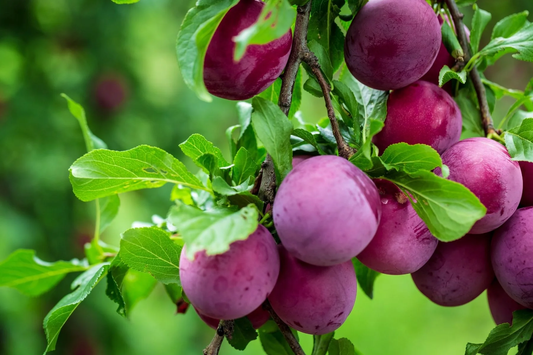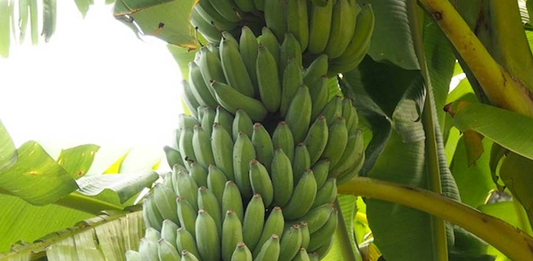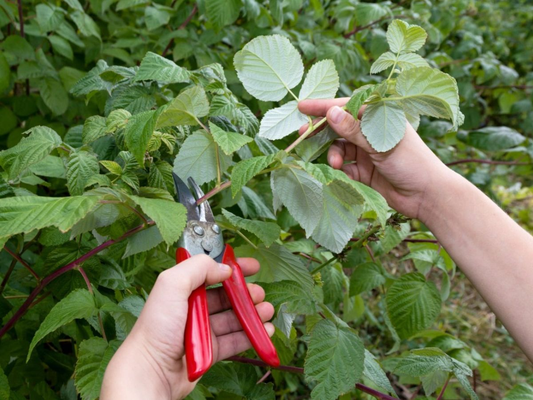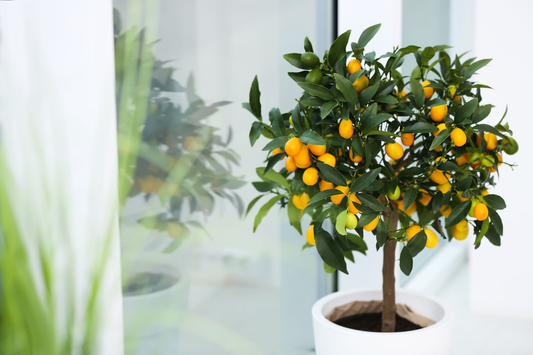Grow Delicious Fruits in Small Spaces: Buy Dwarf Fruit Trees Online Today!
Share
Table of Contents
1. Introduction
Growing fruit trees in small spaces is becoming an increasingly popular choice for urban dwellers and gardening enthusiasts alike. With limited yard space, many gardeners are turning to creative ways of cultivating fresh, homegrown fruit. One of the most effective solutions to this challenge is the use of dwarf fruit trees, which are compact, easy to manage, and ideal for small gardens, patios, or even balconies.
As the demand for more sustainable, homegrown food rises, the popularity of dwarf fruit trees has surged. These smaller varieties of fruit trees not only provide delicious, homegrown produce but also offer the perfect solution for those living in urban areas or with limited garden space. Whether you have a small backyard, a rooftop garden, or a sunny balcony, dwarf fruit trees can thrive in spaces that would otherwise be too small for traditional trees.
In this article, we will explore:
- The benefits of growing dwarf fruit trees in small spaces.
- Why buying dwarf fruit trees online is a great option for urban gardeners.
- How dwarf fruit trees fit perfectly into modern gardening solutions, making them ideal for compact urban spaces.
Here’s why dwarf fruit trees are a fantastic choice for anyone looking to grow fruit in small spaces:
- They are space-efficient and fit into tight corners, balconies, and small backyard gardens.
- These trees are easy to manage and require minimal maintenance compared to full-sized trees.
- Dwarf fruit trees can be grown in containers, offering flexibility and portability.
- They produce delicious, fresh fruit that is often ready to harvest sooner than standard trees.
Furthermore, buying dwarf fruit trees online provides you with access to a wide variety of species, specialized nurseries, and the convenience of home delivery. With just a few clicks, you can have your dream fruit tree delivered to your doorstep, ready to be planted and enjoyed. This convenience, paired with the compact size of dwarf fruit trees, makes them a perfect addition to urban living spaces.
Throughout this article, we will cover the various aspects of purchasing dwarf fruit trees online, from choosing the right tree for your space to ensuring it thrives in your garden. Let’s dive into why buying dwarf fruit trees online is an excellent choice for those who want to enjoy homegrown fruit, even in small spaces.

2. What Are Dwarf Fruit Trees?
Dwarf fruit trees are compact, smaller varieties of traditional fruit trees that are specifically bred to grow to a much smaller size while still producing full-sized fruit. These trees are ideal for small spaces such as urban gardens, patios, or balconies, where traditional fruit trees may not fit. They typically reach a height of 3 to 8 feet, making them perfect for confined spaces where larger trees might be impractical.
Differences Between Dwarf, Semi-Dwarf, and Standard Fruit Trees:
- Dwarf Trees: These trees are the smallest and most space-efficient, usually growing to 3-6 feet tall and wide. They offer the fastest fruit production, often bearing fruit in 1-3 years.
- Semi-Dwarf Trees: These trees are slightly larger, typically growing 8-12 feet tall. They take a bit longer to mature and produce fruit but still offer a compact growth habit compared to standard trees.
- Standard Trees: These are the full-sized fruit trees that can grow 15-30 feet tall or more. They require more space, take longer to mature, and produce more fruit than dwarf trees.
Popular Dwarf Fruit Trees and Their Characteristics:
- Dwarf Apple Trees: Known for their compact size and early fruit production, these trees grow to about 3-5 feet tall and can be grown in containers.
- Dwarf Peach Trees: Typically reaching 4-5 feet in height, dwarf peach trees are perfect for small spaces and produce delicious, juicy peaches.
- Dwarf Cherry Trees: These trees stay around 4-5 feet tall and produce small, sweet cherries that are perfect for eating fresh or baking.
- Dwarf Plum Trees: Growing to about 4-6 feet, dwarf plum trees produce vibrant, flavorful plums and are perfect for small yards or containers.
3. Why Buy Dwarf Fruit Trees Online?
Purchasing dwarf fruit trees online has become a popular choice for gardeners seeking convenience, variety, and specialized products. Buying online offers numerous advantages, especially for those living in urban areas or with limited access to local nurseries. Here are some of the key benefits of purchasing dwarf fruit trees online:
- Convenience of Shopping from Home: One of the biggest advantages of buying online is the ability to browse and shop for dwarf fruit trees from the comfort of your own home. No need to visit multiple nurseries or carry heavy trees back from the store — everything can be ordered with just a few clicks.
- Wide Variety Available: Online nurseries offer a far wider selection of dwarf fruit trees compared to most local garden centers. You can find rare varieties and specialty trees that may not be available nearby, expanding your choices and ensuring you find the perfect tree for your garden.
- Access to Specialized Nurseries: Many online retailers specialize in dwarf fruit trees, giving you access to expert advice, top-quality products, and knowledgeable staff who understand the specific needs of these trees. You’re more likely to find healthy, disease-free plants when buying from a specialized nursery.
- Time-Saving and Easy Delivery Options: Online purchases save you time, as you can place an order at your convenience. With delivery services, your dwarf fruit trees will be sent directly to your door, often with minimal wait times. Many companies offer fast and reliable shipping options, sometimes with tracking information to monitor the delivery progress.
Potential Drawbacks of Buying Online:
- Not Being Able to Inspect the Tree in Person: One potential downside to buying plants online is that you cannot physically inspect the tree before purchase. This could lead to concerns about the tree’s quality or health. However, reputable online nurseries offer detailed product descriptions, high-quality images, and customer reviews to help mitigate this issue. Many also offer a return or replacement policy if the tree arrives damaged or unhealthy.
- Limited Knowledge of Local Climate Conditions: Online nurseries may not always be familiar with your specific local climate or soil conditions. To address this, it’s important to read the care instructions carefully, and you can always reach out to customer support for additional advice on which trees will thrive in your environment.

4. Benefits of Growing Dwarf Fruit Trees in Small Spaces
Growing dwarf fruit trees in small spaces offers a range of advantages, making them an ideal choice for urban gardeners or anyone with limited yard space. These compact trees are not only space-efficient but also highly versatile, thriving in a variety of environments. Let’s take a closer look at the key benefits of growing dwarf fruit trees in small spaces:
- Space-Saving Benefits: Dwarf fruit trees are significantly smaller than traditional fruit trees, typically growing to only 3 to 8 feet tall. This compact size makes them perfect for small yards, urban gardens, or even tiny patios. By occupying less space, they allow you to grow fruit in areas where larger trees would be impossible. They are the perfect solution for limited spaces without sacrificing the enjoyment of fresh, homegrown fruit.
- Ideal for Apartments, Small Gardens, Balconies, and Patios: Whether you live in a high-rise apartment with limited outdoor space or have a small urban garden, dwarf fruit trees fit perfectly into compact environments. They can be easily placed in sunny corners or along walls, making them an excellent choice for gardeners in cities or those without access to large plots of land. Dwarf fruit trees also do well on balconies and patios, as they don’t require extensive space to thrive.
- Low-Maintenance and Easy-to-Manage Trees: One of the biggest advantages of dwarf fruit trees is their low-maintenance nature. These trees require less pruning, less water, and less fertilizer compared to full-sized trees. Their manageable size makes it easy to tend to them, whether you are a seasoned gardener or a beginner. Dwarf fruit trees are also less prone to disease and pests, reducing the time and effort required to maintain them.
- Versatility: Can Grow in Containers: Dwarf fruit trees are extremely versatile in that they can be grown in containers, making them perfect for those who don’t have a garden or want to move their trees around. Container gardening is ideal for apartments, rooftops, patios, and even for those with limited ground space. Growing in containers allows for better control over soil quality, watering, and drainage, which helps the tree thrive even in small spaces.
- Faster Fruit Production: Dwarf fruit trees often produce fruit much faster than their full-sized counterparts. While standard fruit trees may take several years to bear fruit, dwarf varieties can start producing in just 1-3 years. This quicker fruit production is a major perk for gardeners eager to harvest their first crop of fresh, homegrown produce.
5. Best Dwarf Fruit Trees to Buy Online
When it comes to purchasing dwarf fruit trees online, there are many fantastic varieties to choose from. These trees offer compact growth habits, fast fruit production, and delicious fruit for your small space garden. Below is a table listing some of the best dwarf fruit trees available for purchase online, along with their varieties, growth habits, and ideal planting seasons.
| Fruit Tree | Variety | Height/Spread | Fruit Type | Ideal Planting Season |
|---|---|---|---|---|
| Dwarf Apple Tree | ‘Pixie’ | 3-4 ft/3-4 ft | Apples | Spring/Fall |
| Dwarf Peach Tree | ‘Bonanza’ | 3-4 ft/3-4 ft | Peaches | Spring/Fall |
| Dwarf Cherry Tree | ‘Bing’ | 4-5 ft/4-5 ft | Cherries | Spring/Fall |
| Dwarf Plum Tree | ‘Pixie’ | 4-5 ft/4-5 ft | Plums | Spring/Fall |
Here is a brief description of each tree listed in the table above:
- Dwarf Apple Tree ('Pixie'): This compact apple tree produces sweet, crisp apples that are perfect for fresh eating or baking. Growing to about 3-4 feet in height and spread, it is ideal for small spaces and containers. It blooms in early spring and typically fruits in late summer to fall, making it a perfect choice for those who want an early harvest. It thrives in full sun and well-drained soil.
- Dwarf Peach Tree ('Bonanza'): The ‘Bonanza’ variety is perfect for smaller spaces and containers, reaching about 3-4 feet tall and wide. It produces delicious, juicy peaches that are ideal for fresh eating, preserves, or desserts. This tree blooms in spring and fruits in late summer, typically around August. It requires full sun and a well-drained, slightly acidic soil to flourish.
- Dwarf Cherry Tree ('Bing'): The ‘Bing’ dwarf cherry tree is a compact variety that reaches about 4-5 feet in height and spread. It produces sweet, dark red cherries, perfect for eating fresh, baking, or making jams. Ideal for small gardens or patios, this tree blooms in spring and fruits in late spring to early summer. It thrives in full sun and well-drained soil, and it’s known for its hardiness.
- Dwarf Plum Tree ('Pixie'): The ‘Pixie’ dwarf plum tree reaches a height and spread of 4-5 feet. It produces flavorful plums that are great for fresh eating, baking, or making jams. The tree blooms in spring and typically fruits in late summer to early fall. It thrives in full sun and requires well-drained soil to grow successfully. This variety is also great for container gardening.
These dwarf fruit trees are perfect for gardeners looking to maximize their space without sacrificing the joy of homegrown fruit. Each of these varieties offers fast fruit production, compact growth, and beautiful blooms, making them a perfect addition to any small garden or patio.

6. How to Choose the Right Dwarf Fruit Tree for Your Space
Choosing the right dwarf fruit tree for your space is crucial to ensuring healthy growth and a bountiful harvest. While dwarf fruit trees are compact and suitable for small spaces, it’s important to consider several factors before making your purchase. Here are the key aspects to consider when selecting a dwarf fruit tree:
-
Space Available (Height and Width):
- Consider the available space in your garden, balcony, or patio. Dwarf fruit trees are smaller than standard fruit trees, but they still require room to grow. Check the expected height and spread of the tree to ensure it fits your available space.
- Measure the area where you plan to plant the tree, and ensure it will have enough room to grow without overcrowding other plants or structures.
-
Climate Suitability:
- Different dwarf fruit trees thrive in different climates. Some trees, such as dwarf citrus trees, require warmer, subtropical climates, while others, like dwarf apple or pear trees, can tolerate cooler climates.
- Check the USDA Hardiness Zone for your location to ensure the tree you choose will thrive in your area's temperature range.
-
Soil Type and Drainage:
- Ensure the soil in your planting area is suitable for the specific type of dwarf fruit tree you're considering. Most dwarf trees prefer well-draining, slightly acidic to neutral soil.
- If your soil is heavy clay or compacted, consider planting in a raised bed or container to provide better drainage and soil aeration.
-
Sunlight Requirements:
- Most dwarf fruit trees require full sunlight (6-8 hours of direct sunlight per day) for optimal fruit production. Be sure to plant the tree in a location that receives plenty of sunlight throughout the day.
- If you're growing your tree in a container, you can move it to adjust the light levels as needed.
-
Personal Taste (What Fruits You Prefer to Grow and Eat):
- Consider what types of fruit you enjoy eating and want to grow. Whether you prefer apples, peaches, cherries, or plums, there's a dwarf variety available to suit your tastes.
- Choosing a tree that produces fruit you love ensures you'll get the most enjoyment out of growing it. Additionally, think about how much space you need for the fruits to ripen and grow properly.
7. Tips for Planting Dwarf Fruit Trees in Small Spaces
Planting dwarf fruit trees in small spaces like gardens, balconies, and patios can be a rewarding experience. These trees thrive in compact areas with proper care. Here are some essential tips to ensure your dwarf fruit trees grow healthily and produce fruit in small spaces:
-
Best Planting Practices for Small Garden Areas, Balconies, and Patios:
- For small garden areas, choose a location that receives full sunlight for at least 6-8 hours a day. If planting on a balcony or patio, make sure the tree is placed in an area where it will have adequate light, as shade can limit fruit production.
- Consider using vertical space or trellises for additional support if growing climbing or espaliered fruit trees. This maximizes space while still offering plenty of room for the tree to grow.
-
Choosing the Right Container or Pot Size:
- For container planting, select a pot that’s large enough to accommodate the tree's root system. A pot that is 18-24 inches in diameter and at least 12-18 inches deep is ideal for most dwarf fruit trees.
- Choose a container with drainage holes to ensure proper water flow and prevent root rot.
-
Importance of Proper Drainage for Container Planting:
- Proper drainage is essential for healthy root development. Without drainage, water can pool at the bottom of the pot, leading to root rot and fungal diseases.
- If your pot doesn’t have drainage holes, you can create your own or choose a pot with a built-in drainage tray to allow excess water to escape.
-
Planting in the Right Direction for Sunlight Exposure:
- When planting your dwarf fruit tree, ensure that it faces the direction that will maximize sunlight exposure. For example, place your tree so it gets direct sunlight throughout the day, ideally from the south or west side of your garden or patio.
- Positioning your tree to avoid shading from structures or other plants can help it grow stronger and produce more fruit.
-
How to Space Trees for Optimal Growth:
- Even though dwarf fruit trees are compact, they still need enough space to grow. Space them at least 3-4 feet apart if planting multiple trees in the ground or in containers. This gives each tree enough room for its root system to expand and prevents overcrowding.
- For container planting, ensure the pots are spaced apart to allow for adequate air circulation, which helps prevent fungal infections and pests.

8. Caring for Dwarf Fruit Trees: Maintenance Tips
Caring for dwarf fruit trees in small spaces involves several key tasks to ensure healthy growth and a bountiful harvest. Whether you’re growing them in containers or small garden areas, here are essential maintenance tips to help your dwarf fruit trees thrive:
-
Watering Needs and How to Avoid Overwatering:
- Proper watering is vital for dwarf fruit trees, especially in containers. These trees generally require deep watering about once a week, depending on the weather conditions and the size of the container or planting area.
- Check the moisture level of the soil before watering. Stick your finger about an inch into the soil; if it feels dry, it’s time to water. Be careful not to let the soil become soggy, as overwatering can lead to root rot.
- In hot weather, you may need to water more frequently, but always ensure the pot or soil drains well to prevent excess moisture from accumulating.
-
Fertilizing Dwarf Fruit Trees: Best Practices for Small Spaces:
- Fertilizing your dwarf fruit tree helps promote healthy growth and fruit production. Use a balanced, slow-release fertilizer formulated for fruit trees, as it will provide the necessary nutrients over an extended period.
- In the spring, fertilize your tree as it begins to grow. You can apply a light feeding in early summer if needed, but avoid fertilizing late in the growing season to prevent unnecessary growth before winter.
- If growing in containers, use a liquid fertilizer or one designed specifically for container plants to ensure that the tree gets the nutrients it needs.
-
Pruning and Shaping to Maintain Compact Growth:
- Pruning is essential for maintaining the compact size of your dwarf fruit tree. Regularly prune any dead, damaged, or crossing branches to encourage a more uniform shape and better air circulation.
- Focus on removing suckers (growth at the base of the tree) to help direct energy to the main trunk and branches. In the spring, lightly prune the tree to shape it and encourage branching.
- For trees planted in containers, pruning helps prevent them from becoming top-heavy, which can make them more prone to wind damage.
-
Pest and Disease Management for Container-Grown Trees:
- While dwarf fruit trees in containers are less likely to face the same pest pressures as ground-planted trees, they are still susceptible to pests such as aphids, spider mites, and scale insects.
- Regularly inspect your tree for signs of pests and treat them promptly with organic insecticides, such as neem oil, or by gently washing them off with water.
- Ensure that your tree's container has proper drainage to avoid fungal diseases. If you notice yellowing leaves or mold around the base of the tree, remove any affected soil and replace it with fresh, sterile soil.
-
How to Encourage Better Fruiting and Healthier Growth:
- To encourage fruiting, ensure your dwarf fruit tree receives enough sunlight (at least 6-8 hours per day) and maintain consistent watering and feeding schedules.
- If your tree isn’t producing fruit, it may need a pollinator. Some dwarf varieties are self-pollinating, but others may require a second tree for cross-pollination to yield fruit.
- Thinning fruit early in the growing season can also improve fruit size and quality by reducing the strain on the tree.
9. The Advantages and Challenges of Growing Dwarf Fruit Trees
Growing dwarf fruit trees offers a unique set of benefits, especially for those with limited space, such as urban gardeners or apartment dwellers. However, there are also some challenges to consider. Below, we’ve outlined the pros and cons of dwarf fruit trees to help you make an informed decision.
| Pros | Cons |
|---|---|
| Ideal for small spaces and containers | Requires regular care and attention |
| Quicker fruit production | Limited yield compared to standard trees |
| Easy to manage and maintain | May need more frequent watering and feeding |
| Great for beginners | Might require winter protection in colder climates |
Challenges:
- Smaller Yields: While dwarf fruit trees may produce fruit faster than standard trees, the overall yield tends to be smaller due to their compact size. To overcome this, consider planting multiple dwarf fruit trees or opting for self-pollinating varieties to maximize production.
- More Frequent Care: Dwarf trees, especially when grown in containers, often require more regular care, including watering, fertilizing, and pruning. However, with proper care and attention, these tasks become manageable, and the rewards are well worth it.
- Winter Protection: In colder climates, dwarf fruit trees may require extra protection during the winter, such as bringing them indoors or covering them with frost blankets. This is especially important for varieties that are less hardy.
Advantages:
- Space Efficiency: Dwarf fruit trees are ideal for small spaces like patios, balconies, or even windowsills, making them perfect for urban gardening. They allow you to grow fruit without taking up a lot of room.
- Quick Results: These trees typically begin producing fruit in 1-2 years, making them a great option for gardeners who want quick satisfaction and a speedy harvest.
- Easy to Manage: Because of their small size, dwarf fruit trees are easier to prune and manage compared to their full-sized counterparts. They also tend to be more forgiving for beginner gardeners.

10. Where to Buy Dwarf Fruit Trees Online
When looking to buy dwarf fruit trees online, it’s essential to choose a reputable nursery that offers healthy plants and reliable service. Here are some trusted online stores that specialize in high-quality dwarf fruit trees:
- Fast Growing Trees – Known for a wide variety of fruit trees, including dwarf options. They provide detailed care instructions and excellent customer service.
- Nature Hills Nursery – Offers a vast selection of dwarf fruit trees, with guaranteed healthy plants and professional shipping practices.
- Willow Creek Nursery – Specializes in dwarf and miniature fruit trees for small spaces, with a strong focus on tree quality and customer satisfaction.
When selecting an online nursery, consider the following tips to ensure you’re making a reliable purchase:
- Customer Reviews and Ratings: Always check customer feedback to gauge the reputation of the nursery. Positive reviews about plant quality and customer service are good indicators of a trustworthy seller.
- Shipping Policies and Guarantees: Ensure the seller offers secure and reliable shipping methods, especially for live plants. Check their delivery times and guarantees for tree survival upon arrival.
- Tree Health and Quality Assurance: Reputable sellers will offer healthy, well-established trees that are free from pests and diseases. Look for nurseries that provide photos of their plants and guarantee their quality.
- Return and Exchange Policies: Before making a purchase, review the seller’s return or exchange policy in case the plant arrives damaged or doesn’t meet expectations.
At Xroci.com, we offer a curated selection of premium dwarf fruit trees that are perfect for small spaces. With our commitment to quality, fast shipping, and excellent customer service, we ensure that your tree-buying experience is smooth and rewarding.
11. How to Prepare Your Space Before Buying Dwarf Fruit Trees
Before purchasing dwarf fruit trees, it’s important to prepare your space to ensure the trees have the best conditions to thrive. Follow these steps to create a suitable environment for your new plants:
- Prepare Your Garden, Balcony, or Patio: Assess the available space to ensure your new trees will have enough room to grow. Dwarf trees need space to spread their roots and branches, so plan for the expected height and spread of each variety. Consider the visibility and accessibility of the space to allow easy care for your trees.
- Ensure Enough Sunlight and Proper Drainage: Dwarf fruit trees typically require at least 6 hours of direct sunlight per day to grow and produce fruit. Choose a location that receives plenty of sunlight. Also, make sure the area has proper drainage to prevent waterlogging, which can harm the roots.
- Prepare Pots or Garden Beds: If you are planting in containers, select pots that are large enough to accommodate the root system of the tree. For garden beds, clear the area of weeds and debris, and ensure the soil is loose enough for root expansion. Consider using raised beds for better drainage and easier access to your plants.
- Test Soil and Adjust for Tree Growth Needs: Before planting, test the soil’s pH and nutrient levels to ensure they meet the needs of your dwarf fruit trees. Most fruit trees prefer slightly acidic to neutral soil (pH 6.0-7.0). If necessary, amend the soil with compost, organic matter, or other soil conditioners to improve its fertility and drainage.
12. Frequently Asked Questions (FAQ)
Here are answers to some of the most common questions about dwarf fruit trees:
-
Are dwarf fruit trees as productive as standard-sized trees?
While the yields of dwarf fruit trees are typically smaller compared to standard-sized trees, they are still productive and provide fresh, delicious fruit. Their compact size makes them a great choice for small spaces, offering plenty of fruit without taking up much room.
-
Can I grow dwarf fruit trees indoors?
While most dwarf fruit trees are typically grown outdoors, certain varieties can thrive indoors with proper care. Ensure the tree receives enough sunlight (typically 6 hours per day), and maintain humidity levels appropriate for fruit production. Some trees may need supplemental light during winter months.
-
Do dwarf fruit trees require special care compared to full-sized trees?
Yes, dwarf fruit trees may require more frequent care, such as regular pruning, watering, and monitoring for pests. However, they are easier to manage in small spaces and require less overall maintenance compared to full-sized trees.
-
How long does it take for dwarf fruit trees to bear fruit?
The time it takes for dwarf fruit trees to bear fruit varies by species, but typically, they begin fruiting within 1-3 years after planting. Some varieties, like dwarf apples or peaches, may produce fruit sooner than others.
-
Can I grow dwarf fruit trees in containers?
Yes, dwarf fruit trees are ideal for container gardening. Be sure to select a large enough container to accommodate the root system and ensure proper drainage. Regularly check for root growth and water the tree consistently, as container-grown trees may dry out faster than those planted in the ground.
Additional Resources
Your Garden's Missing Piece: The Best Herbs for Outdoor Gardens Explai – XRoci
Want Bigger Pumpkins? Here’s Exactly How to Grow Pumpkin Seeds to Maxi – XRoci
How to Care for Indoor Plants During Summer: Avoid These Common Mistak – XRoci




